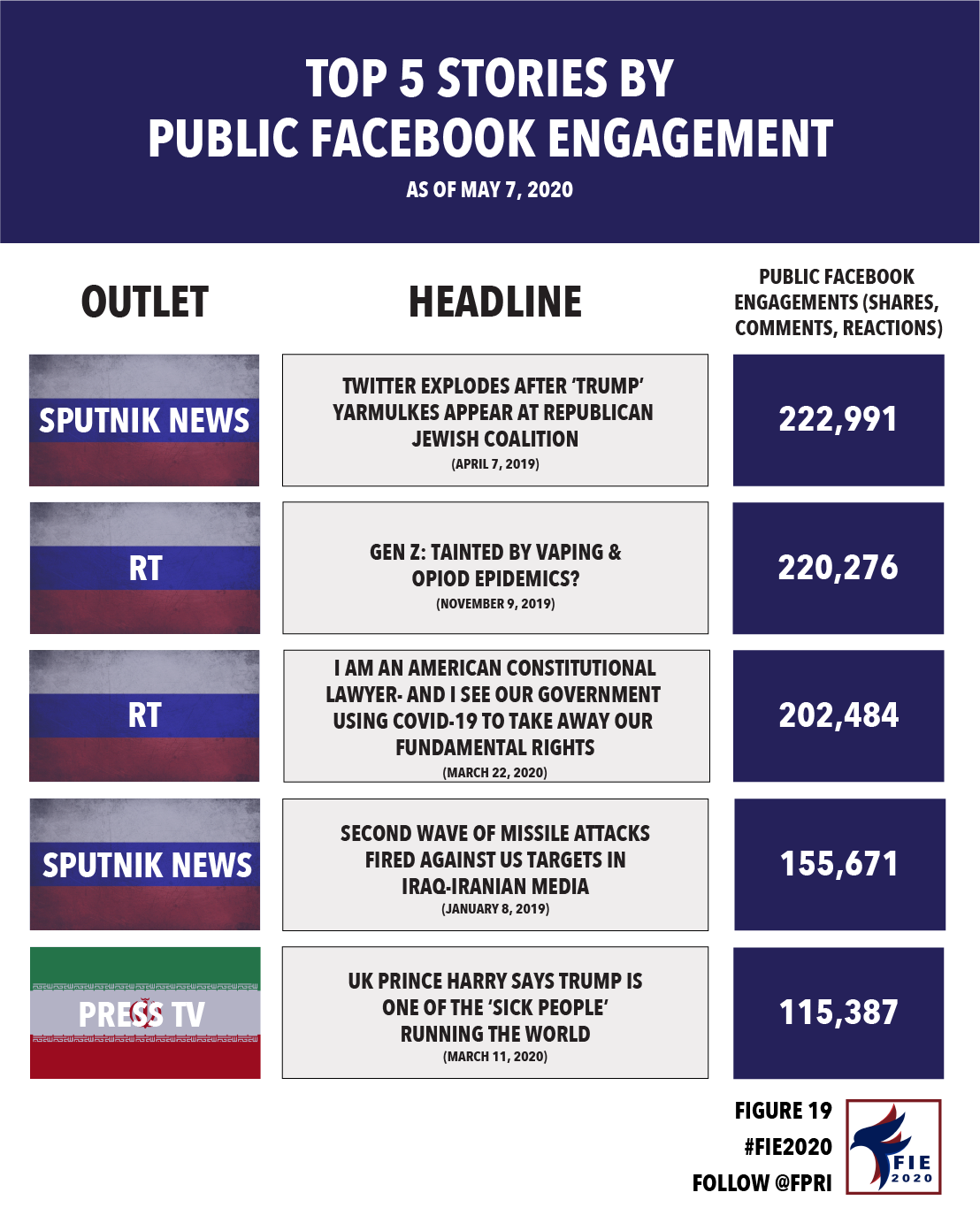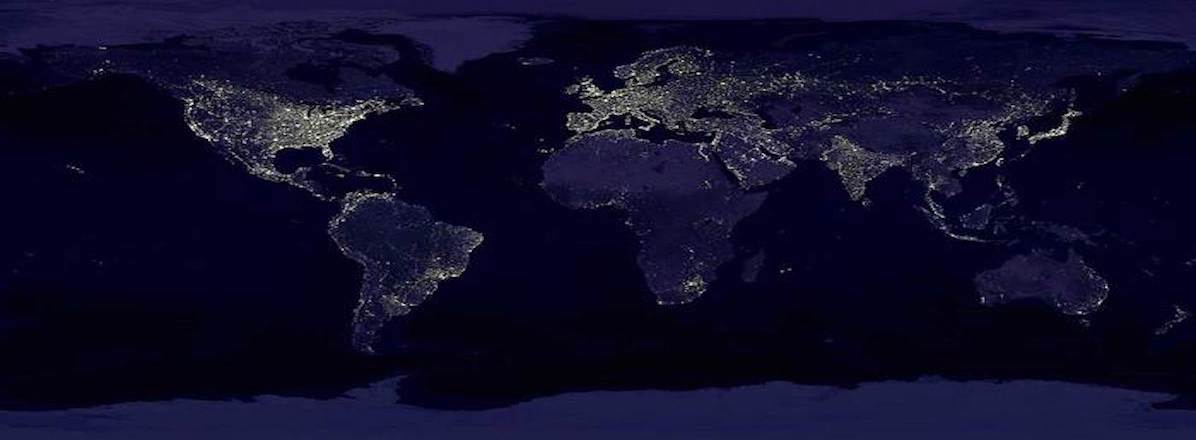A nation must think before it acts.
Comparing the Social Media Reach of Chinese, Iranian and Russian State-Sponsored News Outlets
May 8, 2020
Post by Cyrena Kokolis
In the aftermath of the 2016 election, through the findings of the U.S. intelligence community, it became apparent that the Russian government orchestrated a broad disinformation campaign across multiple social media platforms aimed at influencing the U.S. presidential election. In light of those findings and the potential for influence operations targeting the 2020 election, a question should be posed in the months leading up to November: What presence do foreign state-sponsored news outlets have on social media during this election cycle, not just from Russia, but from all governments interested in influencing the results of the election?
To answer this question, the Foreign Influence Election 2020 Project examined the social media accounts and Facebook activity generated by thousands of articles from four different Chinese, Russian, and Iranian state-run news sources—RT and Sputnik News (Russia), PressTV (Iran) and the Global Times (China). FIE 2020 examined the public Facebook engagement—measured in shares, comments and reactions—of 2,670 Chinese, 4,916 Iranian and 7,988 Russian catalogued articles. The articles, published from January 1, 2019 to April 21, 2020, were catalogued based on explicit mentions of the 2020 election, 2020 candidates or a relevant political issue, like COVID-19 or American tech companies (see FIE 2020’s project methodology here).
As of May 7, 2020, China’s media outlet the Global Times generated the least public activity on Facebook. The 2,670 stories catalogued from the Global Times received only 2,619 Facebook shares in total, with roughly 80% of the Global Times articles receiving no public Facebook engagement at all (as of May 7). At first glance, these numbers make sense—Facebook is banned in China by way of the state Internet censorship apparatus known as the Great Firewall, and as such, Chinese state-sponsored media outlets, even those with English-language or international versions, may not be primarily concerned with promoting their articles’ presence. Low engagement with stories may also reflect the historically limited production of English-speaking propaganda aimed at Western audiences by China. However, despite low public engagement, the Global Times has some of the highest follower counts on its social media platforms. See the chart below for the Global Times’s social media reach across Twitter, Facebook, Instagram and YouTube as of May 5, 2020.

Iranian PressTV articles show more public Facebook engagement than Chinese articles. The 4,916 catalogued articles from PressTV received 108,117 public Facebook shares in total as of May 7. Despite higher engagement on Facebook with its stories, PressTV is the only outlet out of the four whose Facebook account is not officially verified and has the smallest following (roughly 18,100 followers). However, PressTV also appears to have a second, more active Facebook account called “Presstv Programs” that has more than 77,000 followers. PressTV has no observed YouTube presence. It should be noted that the outlet’s restricted reach is sometimes due to deliberate intervention on the part of social media platforms. YouTube shut down PressTV’s channel in January 2020 for violation of the site’s terms of service for the fourth time since the channel’s establishment in 2009. See the chart below for PressTV’s social media presence across Twitter, Facebook and Instagram as of May 5.

Russia is far and away the country with the most active public Facebook audience of the three nations studied. The 7,988 Russian articles analyzed, pulled from state-sponsored news websites Sputnik News and RT, received roughly 1.13 million shares in total as of May 7. Furthermore, most of the articles analyzed (roughly 98%) displayed some form of public Facebook engagement. See the chart below for both outlets’ social media presence on Twitter (RT, Sputnik), Facebook (RT, Sputnik), Instagram (RT, Sputnik) and YouTube (RT, Sputnik) in followers as of May 5.

Both Russian outlets have fewer followers than China’s Global Times on Facebook —Sputnik has 1.3 million followers and RT has 6 million as of May 5. That said, Russian news sources lead in overall public Facebook activity, likely illustrating amplification of the outlets’ content and reflecting the resources invested in Russian state-sponsored media. RT and Sputnik News both have high follower counts on their main English-language accounts, but both outlets also publish content in other languages on accounts dedicated to other audiences. For example, Sputnik News and RT’s various Instagram accounts, including Sputnik Iran, Sputnik France, Sputnik Kyrgyzstan, Sputnik Germany, RT UK and more, each with several thousand followers, demonstrate the news outlet’s broad demographic and geographic appeal. See the chart below for the top five stories by public Facebook engagement for all four outlets as of May 7, with two stories published on Sputnik News, two stories published on RT and one story published on PressTV.

The disparate reaches of Chinese, Iranian and Russian news outlets on social media clearly reinforces Russia’s status as the most persistent threat to information integrity in the 2020 presidential election via overt social media. However, we should not discount the disinformation efforts of Chinese or Iranian media in any way, as they often utilize each others’ disinformation to advance their own goals. In a time when more than half of Americans get at least some of their news from social media, it is imperative we become aware of the presence that all forces wishing to deliberately mislead the electorate maintain on these platforms.




